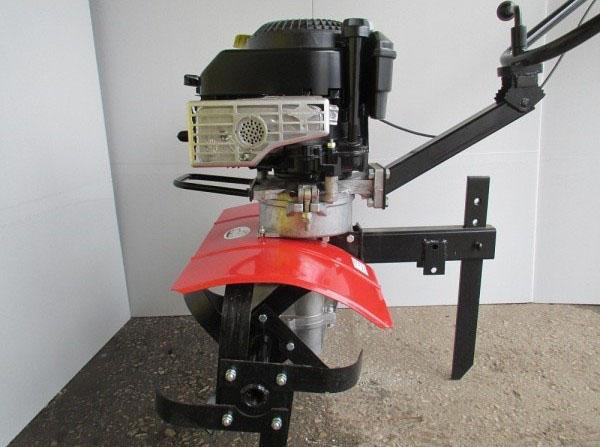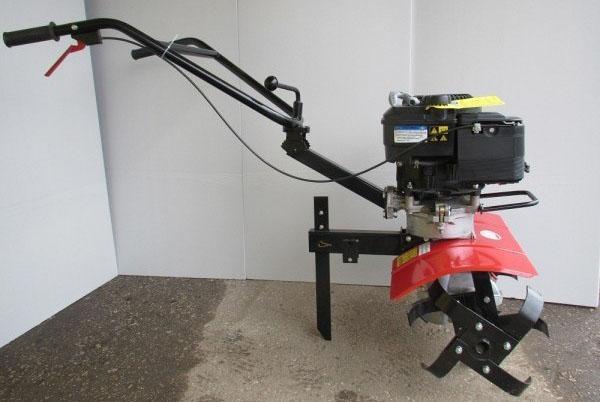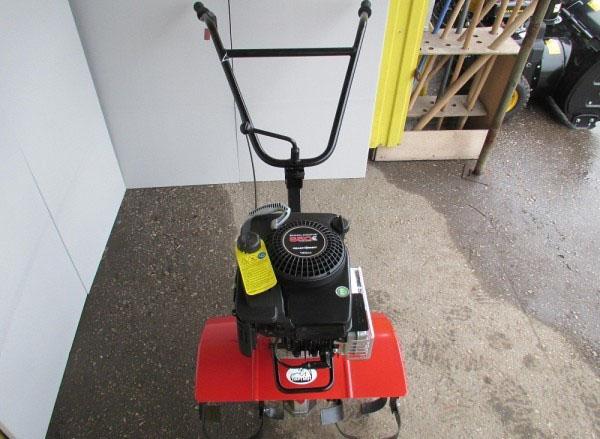Gasoline cultivator Tarpan to help the summer resident
 The Tarpan cultivator was developed in 1991. After many modifications and improvements, in 1997 it was sent to mass production. It quickly gained popularity with buyers thanks to its powerful and reliable Briggs and Stratton engine manufactured in the USA. This mid-range motor-cultivator easily and efficiently processes clay soils.
The Tarpan cultivator was developed in 1991. After many modifications and improvements, in 1997 it was sent to mass production. It quickly gained popularity with buyers thanks to its powerful and reliable Briggs and Stratton engine manufactured in the USA. This mid-range motor-cultivator easily and efficiently processes clay soils.
Tarpan's device
Tarpan cultivators are equipped with four-stroke carburetor engines Champion, Honda or Zongshen with a capacity of 5.5 liters. from. And also the American "Briggs and Stratton" with a capacity of 6 liters. from. The fuel used is gasoline with an octane rating of at least 85.

If the cultivator has buried its cutters in the ground and stopped moving, it must be slightly raised.
 Besides the standard plowing function, the Tarpan cultivator can be used for weed control or fertilizer mixing. To do this, you need to install additional equipment. Experts recommend cultivating heavy clay soils for them, since it has a high torque, thanks to which the soil is easily and efficiently crushed. The depth of travel of the cutters is changed by moving the adjuster in the bracket.
Besides the standard plowing function, the Tarpan cultivator can be used for weed control or fertilizer mixing. To do this, you need to install additional equipment. Experts recommend cultivating heavy clay soils for them, since it has a high torque, thanks to which the soil is easily and efficiently crushed. The depth of travel of the cutters is changed by moving the adjuster in the bracket.
Before you start working with the Tarpan cultivator, you should carefully study the instruction manual.
Specifications:
- power - 40.5 and 4.41 kW (only American engine);
- reducer - worm gear, single-stage;
- the displacement of the American engine "Briggs and Stratton" is 190 cm3, Japanese Honda - 160 cm3;
- cutter diameter - 32 cm;
- fuel tank capacity - 1100 ml;
- the required amount of oil - "Briggs and Stratton" - 600 ml, Honda - 550 ml;
- 1 speed (forward);
- plowing depth - 200 mm;
- width - 560 mm;
- the level of the emitted sound - 81 dB;
- weight - 45 kg.
 The working width depends on the number of cutters installed on the cultivator. Its indicator varies from 35 cm and can reach up to 1 m. With a loosening depth of 18 cm, this cultivator can cultivate 0.06 hectares in 1 hour. For 1 hour of operation, no more than 1100 ml of fuel is consumed.
The working width depends on the number of cutters installed on the cultivator. Its indicator varies from 35 cm and can reach up to 1 m. With a loosening depth of 18 cm, this cultivator can cultivate 0.06 hectares in 1 hour. For 1 hour of operation, no more than 1100 ml of fuel is consumed.
Advantages and disadvantages
The positive aspects of the Tarpan motor-cultivator include easy operation, as well as high-quality loosening of the soil. The steering wheel of the device can be turned so that during processing you do not go on already plowed ground. The maximum angle of inclination during operation, according to the instructions for the Tarpan cultivator, is 15 °.
The main disadvantage is the lack of reverse gear. If necessary, you have to manually pull it, as a result, because of this, the cutter begins to drag the earth with it. Therefore, it is recommended to use it on straight sections where there is not a large number of plantations.
Optional equipment
 To expand the capabilities of the Tarpan cultivator, attachments are purchased separately. The following implements can be connected to it:
To expand the capabilities of the Tarpan cultivator, attachments are purchased separately. The following implements can be connected to it:
- Hiller, consisting of a frame and dumps, it is used for hilling vegetable crops, as well as creating furrows and cutting beds (should be used only together with weeders to create the necessary pulling force).
- Pololniki are a hub with lugs and knives fixed on it. They are used for loosening and weeding.
- Protective discs - thanks to them, during the processing of row spacings, the plants will not be damaged or covered with soil. Installed on the hub.
- Lawn mower - mounted instead of the entire executive unit. Used for cutting lawn grass. There is also a version of the mower that is used for working in hard-to-reach places, for example, near fences or curbs.
- A transport device consisting of wheels with a diameter of 19 cm. It is used to move the cultivator over the cultivated area.
- The plow is also mounted instead of the executive unit. Thanks to him, you can loosen virgin soil or prepare it for winter.
 The price of the Tarpan cultivator depends on the engine installed on it. Devices with a Japanese engine are more expensive than an American one. The most budgetary one is Champion, as it is made in China.
The price of the Tarpan cultivator depends on the engine installed on it. Devices with a Japanese engine are more expensive than an American one. The most budgetary one is Champion, as it is made in China.